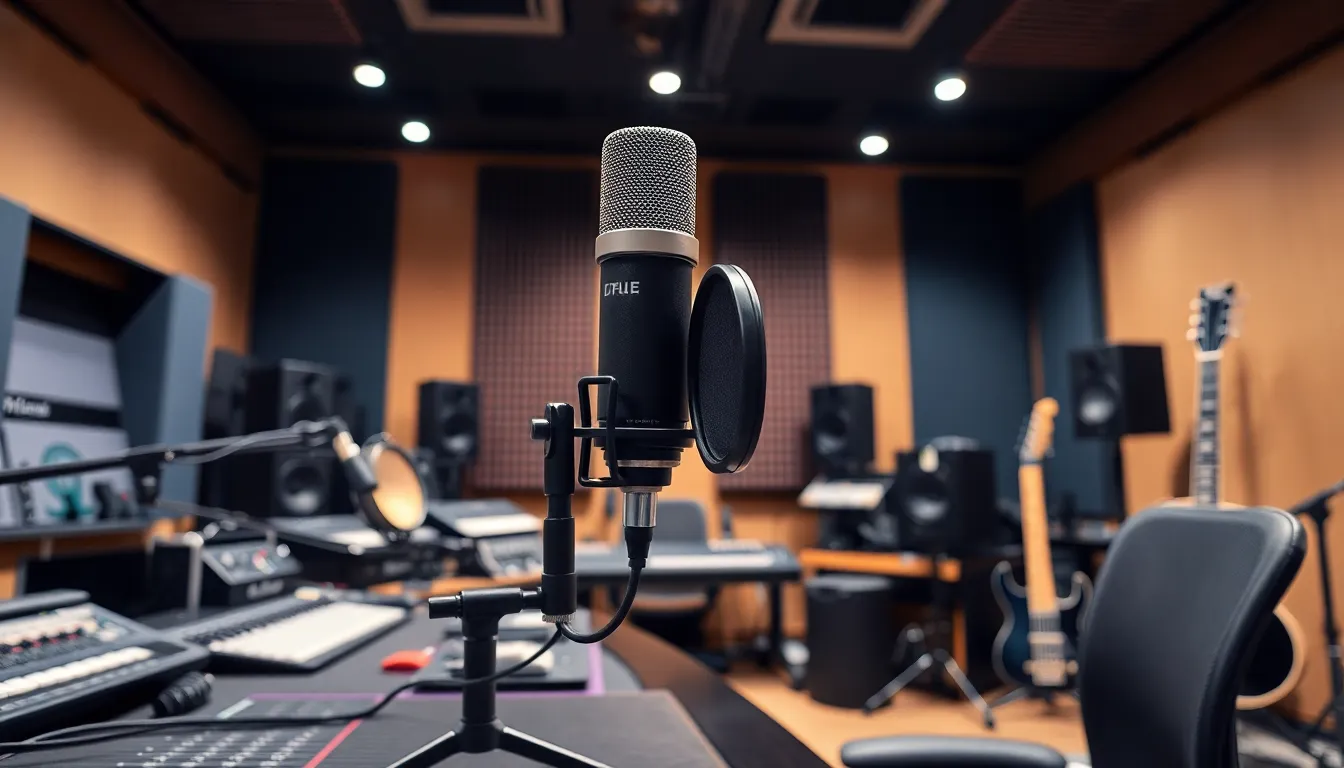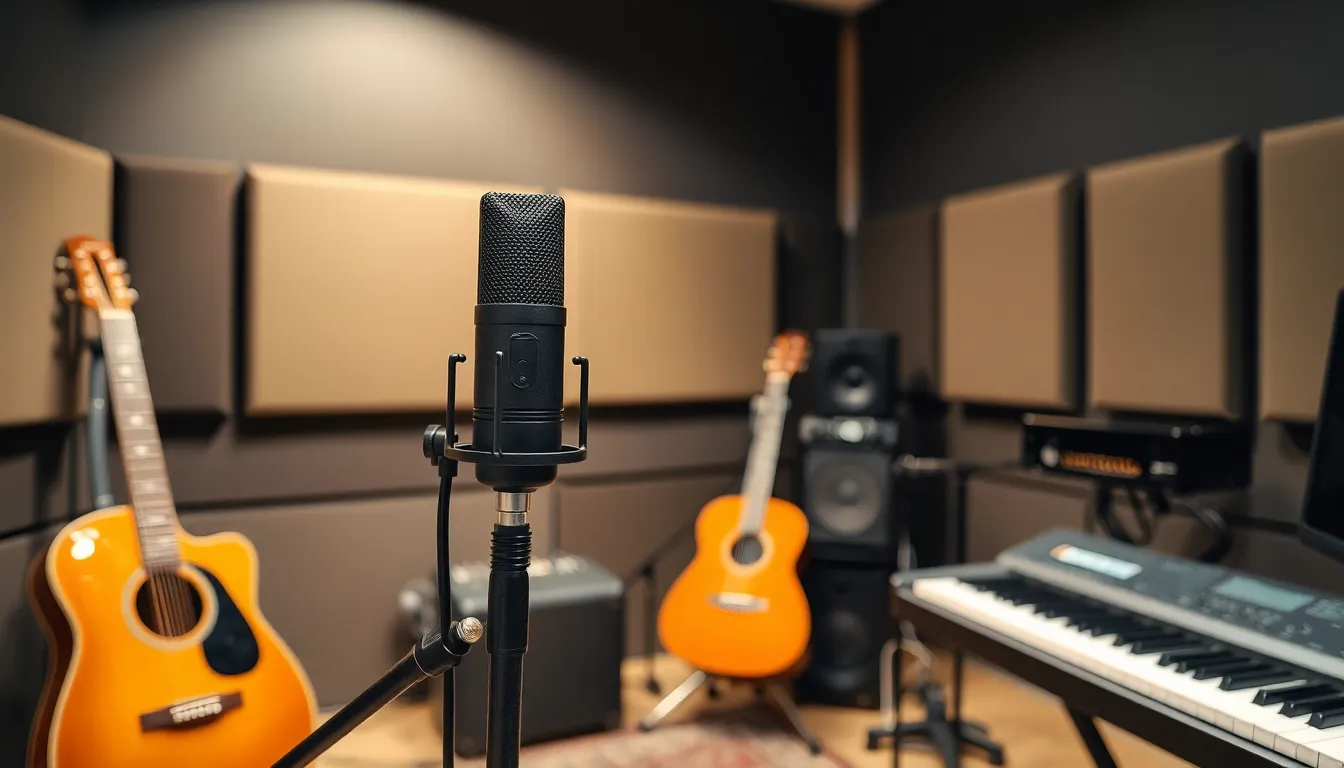In the world of audio recording, condenser microphones reign supreme, capturing sound with a clarity that could make even a cat’s meow sound like a symphony. Whether you’re a budding podcaster or a seasoned musician, these mics are the secret sauce that can elevate your recordings from “meh” to “wow.” They’re not just tools; they’re your sonic sidekicks, ready to help you unleash your creativity.
But let’s face it, choosing the right microphone can feel like dating in the digital age—overwhelming and full of bad options. Fear not! This guide will break down everything you need to know about condenser microphones, from their inner workings to how they can transform your sound. Get ready to discover why these mics are the rock stars of the audio world and why your recordings deserve nothing less.
Table of Contents
ToggleOverview of Condenser Microphones
Condenser microphones play a crucial role in professional audio recording. Their design allows for precise and accurate sound capture, appealing to musicians and podcasters alike.
What Are Condenser Microphones?
Condenser microphones, often found in studios, use a diaphragm coated with a conductive material. This diaphragm vibrates in response to sound waves, creating an electrical signal. Many models feature a phantom power requirement, enhancing their sensitivity. Diverse applications exist, from vocals to instruments, making them versatile. High-frequency sounds capture effortlessly, which contributes to their popularity in quality recordings.
How Do They Work?
Condenser microphones function through capacitance changes. When sound waves hit the diaphragm, the distance between it and a backplate alters, causing variations in capacitance. An onboard amplifier or external phantom power energizes the microphone, boosting the signal. This boost allows for clearer audio during recording or broadcasting. Additionally, many condenser microphones include low-cut filters and pads, enhancing functionality.
Types of Condenser Microphones

Condenser microphones come in various types, each serving specific recording needs. Understanding the differences enhances the recording experience.
Large-Diaphragm Condenser Microphones
Large-diaphragm condenser microphones excel in capturing vocals and instruments with warmth and depth. These models often feature diaphragms measuring 1 inch or more, allowing for greater sensitivity to sound pressure levels. They also provide a richer low-frequency response, ideal for capturing nuances in acoustic performances. Many professionals consider large-diaphragm models versatile and suitable for studio recordings, voiceovers, and live performances.
Small-Diaphragm Condenser Microphones
Small-diaphragm condenser microphones focus on detail and accuracy. Measuring less than 1 inch, these mics effectively capture high frequencies, making them perfect for instruments like violins and acoustic guitars. They provide a fast transient response, ensuring precision for detailed recordings. Often utilized in live settings and broadcasting, small-diaphragm models thrive in capturing the nuances of sound. Many engineers appreciate their clarity and ability to handle high sound pressure levels without distortion.
Key Features to Consider
When selecting a condenser microphone, several features play a vital role in performance and quality. Understanding these elements ensures an informed choice tailored to specific recording needs.
Frequency Response
Frequency response describes how well a microphone captures various sound frequencies. A broad frequency response allows for a more accurate representation of sound. Typically, a range of 20 Hz to 20 kHz satisfies most recording applications. Microphones with flat frequency responses provide neutrality, suitable for studio recordings. Some models emphasize specific frequencies, adding warmth or presence to vocals. These tailored frequency responses benefit specific instruments or sound sources. Ultimately, choosing the right frequency response affects the recorded sound’s naturalness and fidelity.
Sensitivity and Self-Noise
Sensitivity measures how effectively a microphone converts sound waves into electrical signals. High-sensitivity microphones capture soft sounds clearly, which enhances versatility in dynamic recording environments. Self-noise refers to the microphone’s inherent background noise during operation. Lower self-noise levels ensure cleaner audio by minimizing interference. Commonly, microphones with a self-noise level below 20 dB are optimal for high-quality recordings. Both sensitivity and self-noise are crucial in determining a microphone’s overall performance, impacting its suitability for various applications. Thus, evaluating these characteristics aids in selecting the ideal condenser microphone.
Best Uses for Condenser Microphones
Condenser microphones excel in various audio recording situations due to their sensitivity and clarity. Their design makes them suitable for capturing both vocals and instruments with precision.
Studio Recording
In studio settings, condenser microphones capture vocals and instruments with warmth and detail. Large-diaphragm models dominate this space, delivering rich sounds ideal for vocalists and musicians. Sound engineers often prefer them for voiceovers because they provide intimacy and presence. These microphones also capture subtle nuances in instrumental performances, making them essential for high-quality studio recordings. Legacy recordings and modern tracks alike benefit from their ability to render emotional expressions in music. Their broad frequency response ensures that every note is heard, blending well with various genres.
Live Performances
For live performances, small-diaphragm condenser microphones shine due to their clarity and accuracy. Artists often select these models for their feedback resistance, even at high sound pressure levels. These mics capture fine details, making acoustic instruments shine during shows. In concert settings, clarity contributes significantly to the audience’s experience, allowing for immersive performances. Their lightweight design helps in easy setup and transport, favoring musicians on the go. Audiences appreciate the excellence in sound quality, which heightens the overall enjoyment of live events.
Condenser microphones stand out as indispensable tools for anyone serious about audio recording. Their ability to capture sound with remarkable clarity makes them a favorite among musicians and podcasters alike. By understanding the various types and features of these microphones, users can make informed choices tailored to their specific needs.
Whether for studio recordings or live performances, condenser microphones offer versatility and exceptional sound quality. With the right model in hand, individuals can elevate their audio projects to new heights, ensuring every nuance and detail is captured beautifully. Investing in a quality condenser microphone is a step toward achieving professional-grade recordings.

